#its insane how much better your art style can be with a different brush this is hitting for me
Explore tagged Tumblr posts
Text
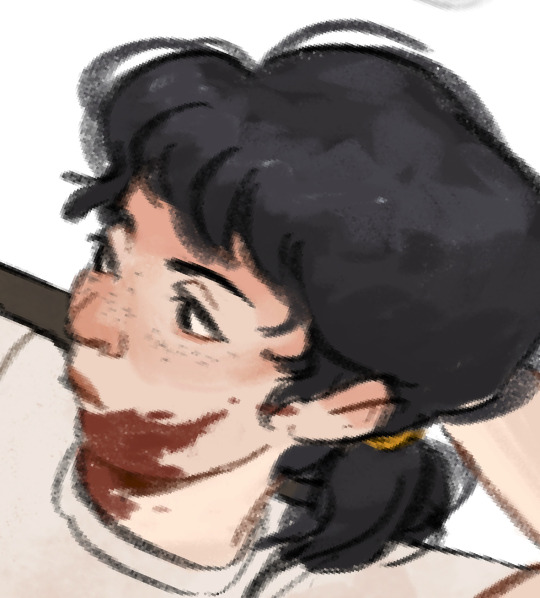
(wip) kinda cooking with this apoc au i won't lie..
#stranger things#byler#wip#st apoc au#i'll make the designs come up with some kind of name and post some ideas maybe? idk i have a notes doc w the ideas#also this fucking chalk brush is about to be my magnum opus brush#its insane how much better your art style can be with a different brush this is hitting for me
117 notes
·
View notes
Note
how do u color so nicely? sorry for such a vague question but your style and the way you color and shade stands out so much to me, its super unique, do you upload speedpaints or anything?
Lol its ok thank you so much! I haven't made a speedpaint since I was like 12 but they were fun so I could record more if anyone would be interested
My actual coloring process is hard to describe (and also generally very inconvenient but its the way I like to do things) so i will do my best to show you using this arcade drawing I never posted:

First my sketches are reallyyyyy messy. Also i draw on a grey background because supposedly it helps you choose better colors but idk if that's true. Also here's my sketch brush for CSP if anyone is interested

Second I put down flat colors. These ones are a little messed up since I erased them as I went later but this is the gist of it. My base coloring is messy and usually doesn't cover all the sketch since I change so much as I go anyway

Third i make a new layer above both the colors and lines layers and just paint over it until I like how it looks. usually my rendered/realistic drawings look bad until I do this. For this piece I had THAT ^ until i decided i didn't like it so I colored over it AGAIN: (colored over instead of restarting bc I liked the face)

NOTABLY, the most important part of my coloring process is probably color jitter. I mostly use a brush called flashito on CSP which has built-in color jitter, but you can turn it on on basically any brush you use. It basically just makes it so that each stroke has a slightly different saturation or hue based on your brush settings. It helps me get the color variety I like and works well with my insane painting process.
usually by the time I'm done painting something, I do so much that I can hide the lines and flat colors layers and it'll be virtually the exact same. Here's my arcade drawing without the flats/lines layers on

It's a little tedious but I like how it looks. This is a long post but honestly in short I think using a brush with color jitter will do a lot for you if you like the way my coloring looks. If u don't want flashito here's how to turn on color jitter on any brush on CSP, not sure about other art programs though

As for shading I honestly think I'm not very good at shading but i'm just critical because I'm myself. Usually i just try to remember that if the lighting is warm then the shadows will be cool or some sort of similar rule. unfortunately i love bright colors so it is hard for me to follow this
#not art#ask#I should start tagging asks#I'm glad my coloring style is unique because my sketching style is so inconsistent so it's my crutch
8 notes
·
View notes
Text
journal 1/ chapters 1-4 / the prologue to graphic design
initial thoughts
When I first received the textbook, the 6th edition of Meggs' History of Graphic Design (written by Philip B. Meggs and Alston W. Purvis) in the mail, I was immediately stressed out. I was unfortunately gifted the trait of being ultra stressed about a lot of things, but school always won first place in amount of stress. (My freshman year of high school I was so stressed I was getting a lot of gray hairs...so embarrassing!) In general, history has been my least favorite subject, and therefore was the subject I struggled with the most. Although I am passionate about graphic design, I wasn't super psyched to be reading about its history. Sorry Professor!
1 / the invention of writing
These terms! I believe I have only heard of pictographs and hieroglyphics before reading this. To read that there's petroglyphs, ideographs, cuneiform, and rebus writing. Wow.
"The symbol for sun...began to represent ideas such as "day" and "light"." (pg.9, Meggs.): You know, I never considered that. On my essay in quiz 1, I discussed how there were would be too many characters to represent every word, and that is why having an alphabet is more advantageous. Though I agree with my argument, I wonder how many symbols would have dual or more meanings, as that is the case for many words in the modern English language. For example, the word "die" could mean the verb of ceasing to exist, or it could mean the noun of a dot-marked playing cube / singular form of dice. So in cuneiform terms, would the symbol for "die" [noun] represent the idea of death? Probably not, but maybe with crazy English it might.
Whenever quarantine ends, I wonder how hard it would be to make my own cylinder seal. After reading this portion, I found the urge to make one. Obviously with modern technology, making a personalized stamp wouldn't be that hard, and I have seen some DIY artists make their wax seals. I think it would be fantastically ridiculous to have an obnoxious stone seal to go around "marking my territory" on.
Ah papyrus. I feel stupid for admitting this, but I didn't actually know papyrus was a plant. I didn't think it was not a plant, however I just never thought of it that deeply. I'm going to look up what it looks like right now. [...] Oh, okay. I suppose today is the appropriate day to say that it sort of looks like thin marijuana? Anyway, speaking of papyrus, the reason I never gave it much thought to it being a plant is because I have been too focused on everyone's hatred for the Papyrus typeface. Why does everyone hate it? I haven't found myself wanting to use it (yet), but I definitely feel this social pressure that I'm not allowed to use it.
I find superstition fascinating. I think if I could meet anyone from the past I would want to meet the illustrator of the Book of the Dead. That would be a morbidlly cool job to have, just feeling that some random guy named Bob has had enough days lived. AND WITH THE POWER OF THE PEN you kill hi- I mean let him enter the afterlife.
2 / alphabets
The definition of an alphabet is definetly something I have not thought about in depth. This definition makes sense, but I always took it for granted in terms of- well I know English, there's an alphabet. I tried to learn Spanish, there's an alphabet... it's almost the same except they're pronounced differently and there's another n- ñ. I tried to learn Japanese, and there's almost twice as many characters (as English), 2 for each sound.
Fascinating to learn that Hebrew and Arabic writing was the evolution of the Phoenician alphabet. I can very much see the resemblances. But it's crazier that different cultures took it in one direction, and then the Greeks took it in another direction, and the Romans took that alphabet in a completely different direction. It blows my mind to see how far we've come.
Ah yes, serifs. I love the whole argument over whether they originated at cleanup marks or sharpening-the-brush-tip marks. Can't we just be glad they exist? (I want to believe it's the sharpening origin, it sounds more efficient.)
Vellum paper feels amazing; no wonder it has to be made from that smooth baby skin. Yikes.
Scrolls are also an obnoxious thing I'd like to have. For instance, I probably will have my will written in a large scroll to represent how dramatic I am.
As someone who used to be obsessed with Kpop, I think it is absolutely amazing that Hangul is such a technical alphabet. It reminds me of how humans have that disk they threw into outer space teaching aliens how to speak English via the shape of your mouth and lips and what position your tongue should go for certain sounds. Obviously this is the origin and is way more impressive especially at such an early point in our history. It makes me appreciate the language and those that write in it much more.
3 / the asian contribution
I appreciated that this chapter starts off crediting the Chinese with creations forcertain things that I remember throughout middle school and high school, history class always seemed to gloss over. Like where did these Europeans know which way was north and to figure they could kill others by putting some powder in their guns. Paper also always came out of nowhere, but I'm glad I learned its origin sooner than reading this.
I have learned that Chinese calligraphy was more important that painting before, but in a different way. As I'm in a lot of art classes, I was taught that Chinese painters would usually also be calligraphers and viewers could tell that the same person who painted the painting wrote the calligraphy as the style of the strokes would match. Thinking about it more now, it would make sense why it would be more important as calligraphy was something you had to memorize AND learn where as with painting, anyone could technically learn how to visualize.
Referencing my earlier rant about cylinder seals, chops are also something I enjoy and would want to have one of my own. Personally I like cooler colors better, so maybe I would choose to have a blue ink instead... but I know that's not the point. I think this would make more sense to be the origin of printing as it is constructing something once and being able to reproduce it over and over just with the use of ink.
The Chinese also invented playing cards! How interesting that they were called sheet dice and a unique aspect of graphic design that you never realize until you actually think about it.
I agree with the authors, it is odd that languages with thousands of characters would decide to use such a tedious method like movable type. On the bright side, we wouldn't have our lovely lazy Susan's if it weren't for this tedious type!
4 / illuminated manuscripts
As someone who appreciates shiny things (my weakness is holographic) it was exciting to learn about illuminated manuscripts. I'm just imagining the gold leaf making the page glow from a couple meters away. Those kind of things make me like to pretend stuff is magical. And for your title to be an illuminator? Yes please. AND to learn that these were insanely portable for a lazy human like me? Perfection.
Earlier this year I learned about ascenders and descenders in typography, so it was nice to know their origin as well as how lowercase and uppercase letters came from minuscule and majuscule.
I am thankful for the Celtics for deciding to put spaces between words. Reading (especially something I'm not interested in) would be a much more painful task ifeverythinglookedlikethis. No wonder humans were evolving so slowly before this point. Howdoyouknowwhenonewordendsandanotherbegins?
All of these illustrations next to the text on the manuscripts make me wonder if they were still using hieroglyphics, would they even bother to illustrate these giant paintings or would it seem (or at least appear) to look repetitive? I particularly enjoy the page from Ormesby Psalter, a Gothic manuscript on page 61; it's very beautifully done.
While I'm not a religious person, I think the concept of aniconism is very interesting. Also how you could view illustrations of living things, but only inside. Can't deny that their commitment to an intricate and complex design in the Islamic manuscripts were not short of beauty.
The Limbourg brothers' story was interesting to me: how they were all illuminated book designers, how they all died before finishing their most well known project, just short of when the duc de Berry died.
This chapter was the roughest for me. I feel that it was a bit long for my tastes and it gave me a bit of anxiety that with it being so long that the professor told us to focus more on chapter 1 than this chapter. That's my issue though and it was still pretty insightful.
post thoughts
I understand the reviews for this book that I read, about how the writing is something I'm going to have to get used to. It is definitely informative, but oh my it is a lot. Will definetly not be doing this journal so late on Sunday night. Sorry professor...
Source: Meggs' History of Graphic Design, 6th Edition, Philip B. Meggs and Alston W. PurvisJohn Wiley & Sons publishers.
1 note
·
View note
Text
Mary Lawton.
Bio: I was born on Long Island, New York in 1958, and loved drawing and making art since I was pretty young. I remember really loving Rat Fink, the anti-hero of Mickey Mouse, and tracing pictures of him. I even had a plastic Rat Fink ring when I was eight. I am the youngest of a very loud and raucous group of six siblings who always encouraged me to make art. My parents were my biggest fans, they would parade their friends through my bedroom to show them the murals I drew on my walls. I read MAD and National Lampoon with a fervor, and I still remember some of the insanely hilarious cartoons I saw in those magazines, although Alfred E. Newman's face gave me nightmares. After backpacking in Europe for a while after high school, I moved to Boston in 1979, and became friends with a bunch of artists, some of them cartoonists and animators. We were all enamored of Lynda Barry and Matt Groening, who were bursting on to the alternative comics scene at the time. I devoured their comics, and also loved Roz Chast, B Kliban, William Steig, Mary Fleener, Gahan Wilson, and many others. I knew that I wanted to do what they were doing.
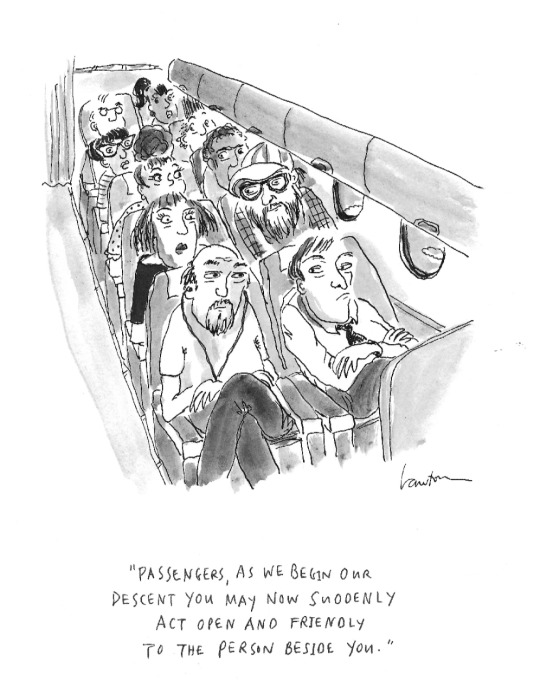
Find this print, here!
I was drawing very primitive, autobiographical strips about my childhood at that time. I sent them out to magazines and newspapers and they began to get published. It was a nice time to be an 'alt' cartoonist as there were so many markets and the pay was great. I also loved cooking, so I worked in restaurants during the day to make a living, and drew in my little bedroom/studio at night. After ten years cooking and cartooning, I left Boston in 1989, moved to Manhattan, and worked at Chelsea Animation, an ink-and-paint studio on 23rd Street. Working there with a great group of like-minded artists was like going to a party every day. Non-stop hilarity. We all sat over our light tables wearing white cotton gloves, painting cels of all sorts of commercial animated films. At that time I took a few classes at the School of Visual Arts at night.
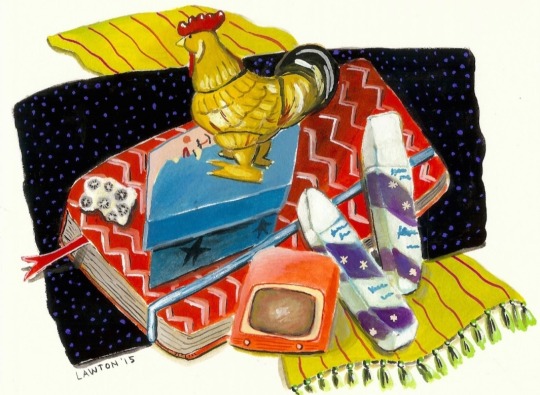
Since then, my art has been in many magazines and newspapers, books, greeting cards, museums and galleries, and I've done a gazillion commissions. In the 1980's I sent samples of my cartoons to William Steig for his advice, because I just loved his drawings and books. He became my friend and mentor, and always encouraged me to send to The New Yorker. I did this for nearly thirty years and finally got one accepted in 2017. I have sold several to The New Yorker online, and a few more in their hard copy magazine. Around the same time, I was invited to join Six Chix, a comic strip by six women, a different one each day of the week, syndicated with King Features. It was created in 2000 by Jay Kennedy, the masterful editor at King, who died tragically in 2007. Mine is the Thursday comic, and every six weeks I draw a Sunday. I love being part of this group of women cartoonists!
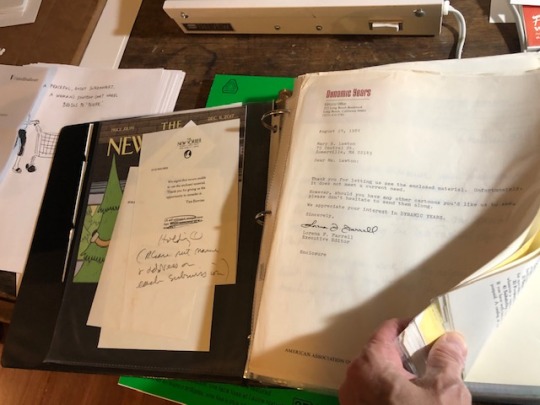
I have saved all of the rejection slips I got since I started sending out my cartoons in the early 1980's. They are in an album that now weighs 4.5 lbs. It's my reminder to never give up, to just keep returning to my work table. Persistence pays.
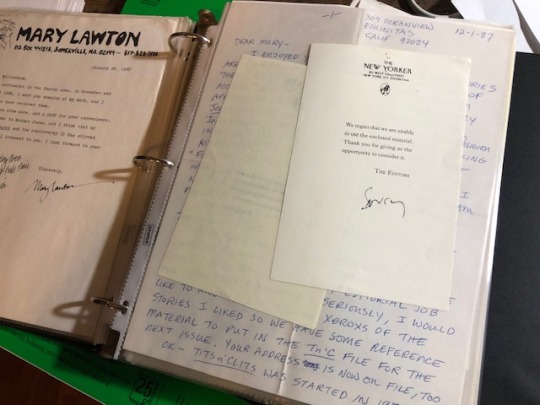
Favorite cartoon: I think my favorite cartoon that I have had published in the New Yorker magazine is my very first [editor’s note: the cartoon at the beginning of the interview], because it was so dang thrilling to finally be in that magazine. I happened to be in New York the week it appeared in print. On my way back home to Texas, as my plane flew over Manhattan at night I looked down at those lights below and I felt like I had really made it. It was a dream come true! Also, since it was an airplane cartoon, I shared it with the flight attendants, who all got a good laugh, and they brought me a glass of champagne. Later that year I was part of the Funny Ladies exhibit at the Society of Illustrators in New York. Liza Donnelly was so kind to invite me to be in the show. To be there on opening night and to meet Emma Allen and the cartoonists that I have admired for so long, felt like being at The Academy Awards. Only better.
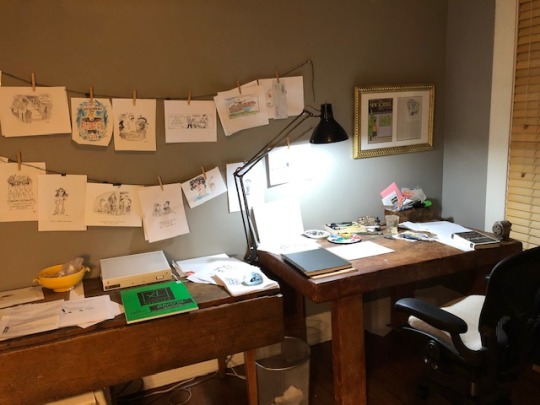
I really love to draw political cartoons, so I'm also proud of the ones that have made it into The New Yorker Daily Cartoon.
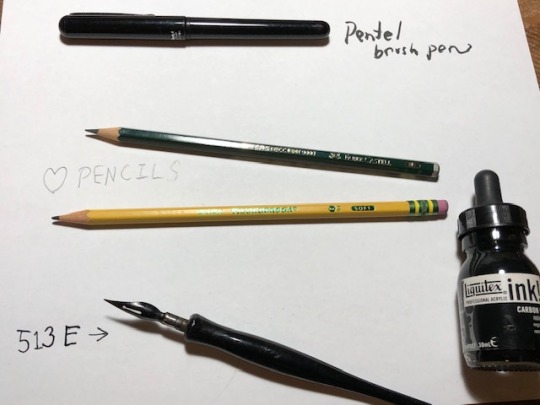
Tools: I drew with Rapidograph pens for many years. I switched to dip pens, which I enjoy depending on the paper. Lumpy or textured paper, ugh. Smooth paper, and it's perfect. I practiced using the dip pen by doing calligraphy for a long time, with lots of different nib sizes and shapes. At the moment I use Pigma Graphic in all sizes, but they are disposable, so I'm on the hunt for a new reusable pen so I don't add to the land fill. I sketch out cartoons in pencil most of the time, then ink in. I love Arches papers, and use them for finishes and gouache paintings. Or Bristol paper. I buy big sheets and cut them up. But every day, I use a lot of printer paper for roughs. The pencils I mostly use are the Faber Castell 9000, in a 3 or 4 B. I also love Ticonderoga pencils, not only for their beautiful name but they feel perfect on Boise all-purpose printer paper. I love paint brushes of all kinds. I use gouache every day. It took me many years to learn about gouache, to finally get how it works. It's complicated because of its soluble nature. I looked at instructional videos on Youtube, and got the hang of it. I use black gouache for my washes, and Titanium White right out of the tube for covering up mistakes, or all sorts of highlights. My old work lamp has a long arm so I can move the light all over my table, which is really handy.
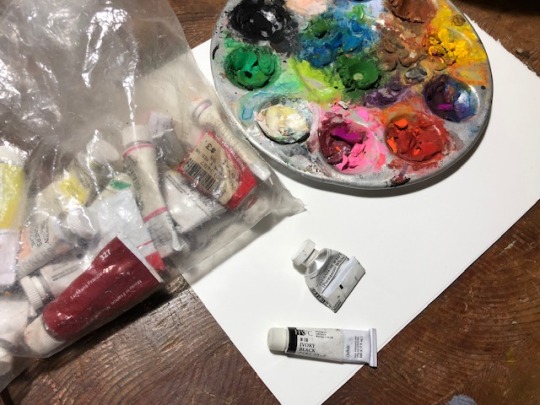
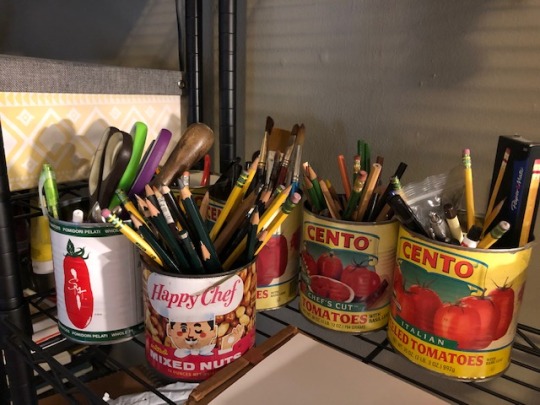
Tools I wish I used better: Sketchbooks! That seems odd, but it's true. My sketchbooks are very messy, and not something I'm proud of, or want to save and look back on. I have seen beautiful sketchbooks which are themselves art pieces, but it's not my style! I mostly want to toss them into the recycle bin once they are full. Also, I wish I could use computer drawing tools.
Tool I wish existed: Can't think of one.
Tricks: I don't look at social media much, and I think that helps my creativity, and certainly gives me more time to do stuff.
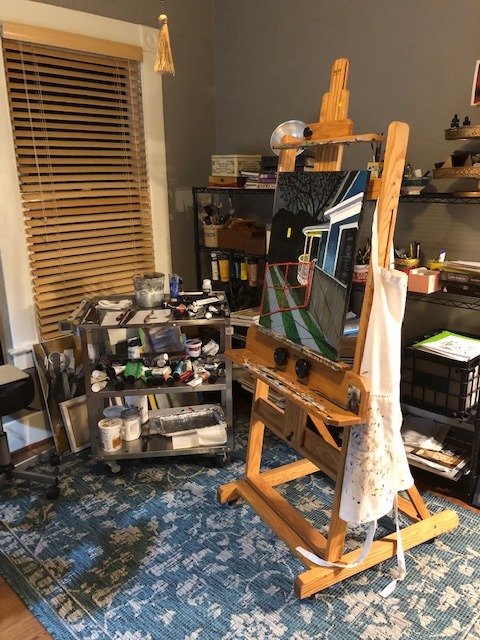
Misc: I have three big-time men in my life, my husband and my two sons. Four, if you count my dog Buddy. All bring me a ton of joy. I've lived in Texas for 25 years, and I encourage visitors! We always like to show folks the Texas we know and love.
Website, etc:
Instagram
newyorker.com
sixchixcomics.com
funnytimes.com
narrativemagazine.com
thenib.com
Editor’s Note: If you enjoy this blog, and would like to contribute to labor and maintenance costs, there is a Patreon, and if you’d like to buy me a cup of coffee, there is a Ko-Fi account as well! I do this blog for free, and your support helps a lot! You can also find more posts about art supplies on Case’s Instagram and Twitter! Thank you!
#mary lawton#how to be a cartoonist#mary lawton cartoonist#artists on tumblr#art supplies#drawing process#art process#cartoons#cartooning
17 notes
·
View notes
Text
Collar full // chp 2.5
summary: the one with all the memories
warning: idk if your hearts can take all the domestication and fluff of the trio
word count: 1284

Skye had packed her toiletries and she had moved back to her room.
Skye was a person of memories. She kept things just for the sake of remembering that moment. So the fact that she now had to wittle all her things down to just a few was killing her.
Skye had to bookshelves in her room. Only one was filled with books; even then, it was only the top three shelves. The bottom shelves and the whole other shelf was just a place to store her things. But it wasn’t just normal books that were on these shelves, oh no. There were journals and diaries and sketch books and notebooks that Skye had written and drawn in throughout the years. One specific sketchbook caught her eye. She reached for the deep green book and flipped through the pages.
Now Skye wasn’t an artist by any means. Her drawings were not remarkable, realistic or had great shading; but they were not terrible either. Skye had found a perfect medium of a “meh” art style. Her thumb let the pages flutter by until she stopped on one specific drawing. It was of two boys, swinging on a swingset, with seemingly perfect, poofy clouds in the sky. Skye remembered the moment perfectly.
“Okay look,” the small boy said. “Aunt May taught me this. She said, you look up at the clouds, and whatever shapes you see, you have to make a story out of it!” his brown eyes were bright with that child-like wonder.
The bigger boy that sat on the swing next to him, tilted his head back, mouth agape.
“Uuuhhh, i see....
a blob. Peter how the heck am I supposed to make a story out of a blob?” He rolled his head and tilted his head back to its normal position.
Across from the swing set, there was Skye, sitting across from her best friends, sketchbook resting on her knees, lightly brushing the pencil across the page. Peter’s head looked back down, right at his best friend.
“Skye, what do you see in the sky?” A little smile broke out on his face due to the two words. Skye set her sketch book next to their bags at the base of the tree, and sat in the swing next to Peter, looking at Ned.
“Ned, you need to have a better imagination for this kind of thing.” She said as she situated herself into the swing. Her head fell back and she glanced up. Her imagination was running wild.
“I see a tree, and a book, some kind of circle thingy, a spider, a cat, and a pizza slice!” Skye rambled on about the different shapes. Her little head craned back around to look at the boys. “Make a story about that!” She teased, her little giggle escaping her body.
Ned had gone completely slack-jawed, not knowing how on earth Skye had just came up with so many shapes out of blobs. Skye looked over to Peter, who also was slack-jawed, but his eyes sparkled.
Skye was jerked back to reality when she continued to flip through pages to find the empty ones in the back. She shook off the memories and tossed the sketch book into her bag. Along with some pens, pencils and markers.
Skye moved from her bookshelf to her little desk, where a bunch of little odds and ends were scattered about. Some cute trinkets, paperweights, or anything Skye liked, she would get and put on her desk. There was one object in particular that jerked at Skye’s heart strings: a little box. Of course, it was what was inside the box that Skye loved so much. She reached out for it and snapped it open, revealing a stunning, and yet simple, moonstone ring.
“Skye, you promised you would keep your eyes closed!” She heard that easily recognizable voice.
“Yeah yeah, just hurry up with it! My mom said they have this big thing planned and we can’t be late for it!” Skye’s all too popular smirk had taken over her face. She held her arms out, stumbling around her own apartment, eventually grasping onto Peter and following him around.
“This will literally take like, two seconds, calm down.” Peter laughed as he spoke, causing the knot in Skye’s stomach to grow tighter. She had never been lead around her own home for her birthday. She was slightly scared.
Soon she felt the carpet under her feet, and knew it was her own bedroom. She let go of Peter. “Alright Parker, what’s going on, can I open my eyes now?” She questioned, crossing her arm, looking slightly to the left of Peter. All she heard was Peter’s soft laugh and the slight bounce of her own bed.
“Alright, alright, open your eyes!” She could hear the smile on his face as she quickly opened her eyes.
There sat Peter, sitting on the edge of her bed, his feet dangling off the side, holding a small, black, jewelry box. Skye’s head fell to the side in confusion.
“What, are you proposing to me now?” She did her best, but she couldn’t fight the smile that was creeping up on her face.
“Oh, stop it.” Skye seemed to miss the slight redness of his face, trying to control her own. “This,” Peter started as he opened the box. “Is a moonstone ring. I was walking through the mall once and I saw it, instantly thought of you.” He reached out for Skye’s right hand and put it on her fourth finger. “I even got one so we can match. Although,” He paused again, fishing a chain out of his front pocket. I’m keeping mine around my neck, don’t need people thinking we’re married, huh?” He said with a smile, elbowing her in her side
Skye couldn’t take it anymore. She hadn’t worn the ring in so long, and she felt guilty and ashamed. She picked up the ring and put in on her finger. She sighed and figured that was enough remembering for now. She figured she should go over to Peter’s place and get some of his things.
Aunt May was, hopefully, still at work as Skye opened their door. She quickly went to Peter’s room, looking around.
The first place she looked at was his desk. It was an absolute mess, the way Peter always was. She moved around some papers, keeping her eyes open for anything that might be useful, but her eye being distracted by something shiny; a chain.
She reached out for it and pulled it out from under all the papers. On the end of the chain lay the very ring that Peter got to match Skye’s ring.
“I guess he doesn’t bring it to school.” She shrugged. Peter never liked wearing necklaces to school, just another thing for Flash to grab while he was fighting. She reluctantly put the chain around her neck. She went to his closet and her eyes landed on his Midtown sweater. Peter loved wearing that sweater, and she knew she had to bring it. She grabbed that and pulled it on over her head, inhaling her best friend’s scent, hoping this wouldn’t be the last time she did so. As she was about to leave, a small journal caught her eye.
It was peaking out from under his mattress. She reached for the small, black book and opened it to a random page before realizing it was a diary. She quickly closed it and saw there were two other journals under the mattress. A blue and red one. Without thinking, she put all three in her backpack and went back to meet Ned before heading off to Stark Tower.
A/N: Hey guys! sorry if this absolutely sucks, but I’ve been insanely busy these past few days and I wanted to finish this as fast as I could so y’all could know that I’m still writing this story :) Also, there were some people that asked to be in the taglist for this series and i forgot their urls (i’M SORRY) so if you’re not on this list and want to, p l e a s e tell me again and i will write it down and remember it.
Anyways, i hope you all enjoyed this little extra chapter thingy, and i will do my best to get chapter 3 out as soon as possible :) thank you for reading and please please please give me feedback!
Tag list:
@ninjamidnight @scarlettxspider @selixjammm @multiposting @choke-me-sweet-pea @peters-vlogs @royalparker @sierramalfoy514 @serpentbucky @topisdead
#peter parker#peter parker x reader#peter x reader#peter parker imagine#fanfiction#peter parker fanfiction#tom holland#tom holland x reader#tom holland imagine#spider-man#spiderman#spider-man x reader#spiderman x reader#spider-man homecoming#spiderman homecoming#spider-man imagine#spiderman imagine#infinity war#infinity war spoilers#peter parker infinity war#tom holland infinity war#Spider-Man infinity war#spiderman infinity war#peter parker x oc#peter parker x female oc#spider-man x oc#spiderman x oc#spiderman x female oc#marvel#marvel fanfiction
18 notes
·
View notes
Text
Lettering in Webcomics - a Reference Post
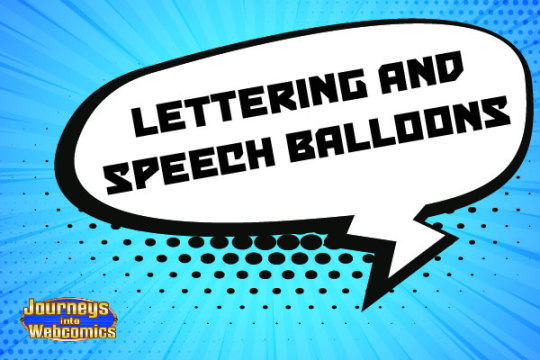
Imagine you have finished the perfect artwork for the latest update for your webcomic. You feel so proud about it you want to hang it on your wall. You want to post it immediately! You want everyone to see it! But before you can do that, you need to add dialogue between your characters.
And that’s where you get stuck. No matter where you place the speech balloons, you’re covering too much of your drawing. It all looks badly placed. You accidentally make a speech balloon that goes from side to side of the frame. It’s a major disaster! What did just happen and how can you avoid it? Let’s answer those questions now.
The charm about comics and webcomics is that they’re a combination of text and images. It’s true its main strength is the fact the reader can look at the art depicted, but a webcomic is never complete without dialogue or text.
However, filling your webcomic to the brim with text and dialogue is not how webcomics work. It’s rare to find the exception to these rules, such as Homestuck, and even then it’s only because of the difference in format. It’d be tedious to read a webcomic that has paragraph after paragraph crammed in a single frame!
As if all that wasn’t enough, you also have to remember that if you place the text badly, it’ll make the reader overlook the art you worked so hard on or even get confused, cardinal sins in this type of work. If you strive to be a webcomic author, you must understand how to place dialogue and text properly. That’s what this post is here for! Here are some handy tips that will allow your webcomic’s text shine without sacrificing anything in the process!
GREAT! WHERE DO I START?
Not so fast, enthusiastic creator! Lettering isn’t something you add in the end. You need to plan this carefully from the beginning. Webcomics are a visual medium, and that’s a double-edged sword. You can communicate a lot through art, but there’s not much space for dialogue unless you plan carefully from the very start. You can’t clutter the page with line after line after line!
That’s why, before starting to draw the page, you need to be aware how much dialogue you’ll have this time. Write it somewhere, analyze how much space you will need. Keep in mind the text is a piece of a larger picture, so to say. You can’t let it overshadow the rest of the page.
I’M DONE PLANNING.
Congratulations on completing the first step! Now you may start drawing. Whether you sketch on paper or digitally doesn’t matter, what matters is that you sketch. Why? Because this way you can plan where you’ll place the speech balloons. It’d be a shame if at the end your dialogue covered too much of the art, this can be easily prevented if you sketch. While you draw, imagine where you may be placing the speech balloon, and avoid drawing too much inside that small area. You also may adjust the size of the frames, leaving enough space for the speech balloons without having to sacrifice part of the art.
So you got your art done! Well done, now place the speech balloon. There are many speech balloons you may use, depending on what you want to communicate.
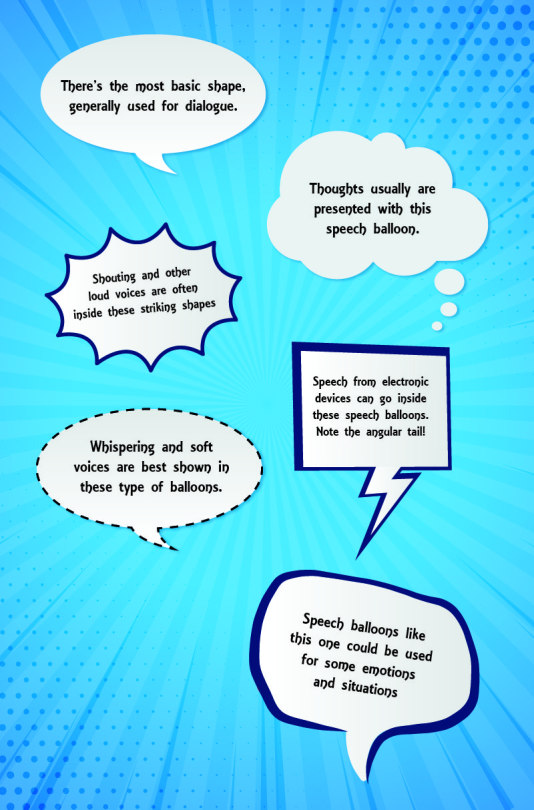
These are more like guidelines, the most used meanings for these type of speech balloons. You as the author of the webcomic have the liberty to adjust speech balloons according to your style and needs. You could modify speech balloons to make them fit a character. Color, shape, font, all that are qualities you can change according to situations. You’re the one who has the last word on the matter!
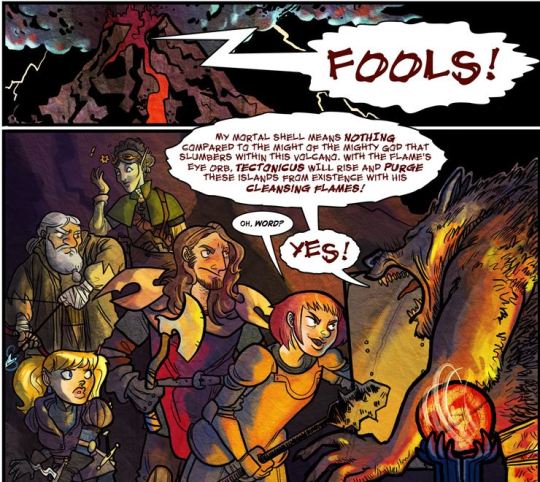
---Guilded Age
To keep your speech balloons orderly, try to accommodate the words in the shape of a square. Avoid long lines, occupy as little space as possible with the speech balloon. Make sure the tails are pointing at the character who is speaking. It doesn’t have to touch the character; all it needs to do is point in the general direction the character is at.
Angelica Maria, the author of Solstoria, mentioned this as her usual technique on how to accommodate text inside a speech bubble:
I try to keep the text in a speech bubble looking like a "Square", so for example
"Oh no, I'm being
held accountable
for my actions!"
The middle line can be extended slightly depending on the shape of the bubble. This is just something I keep in mind, it's not something you have to follow to a T or anything. I just want to make the lettering look somewhat good.
Wait, but how to position the speech balloons? Generally, it’ll be better to position them in a way that’ll guide the reader’s eyes in a natural direction – left to right, in other words. Take this for example:
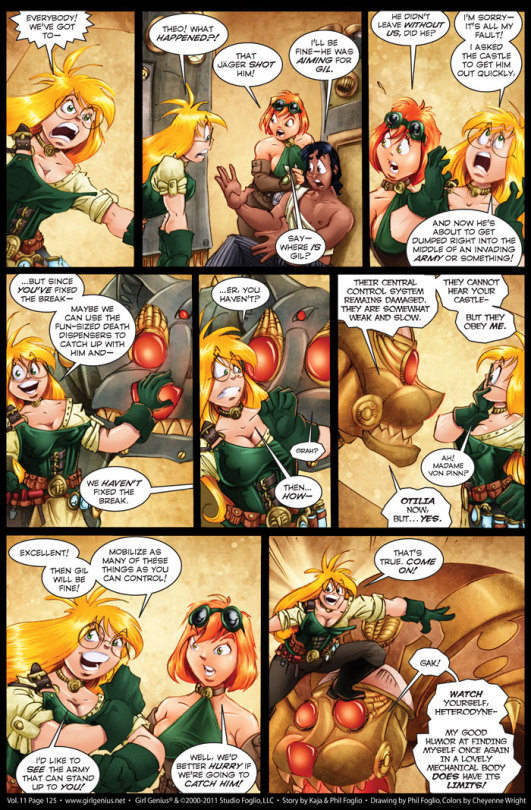
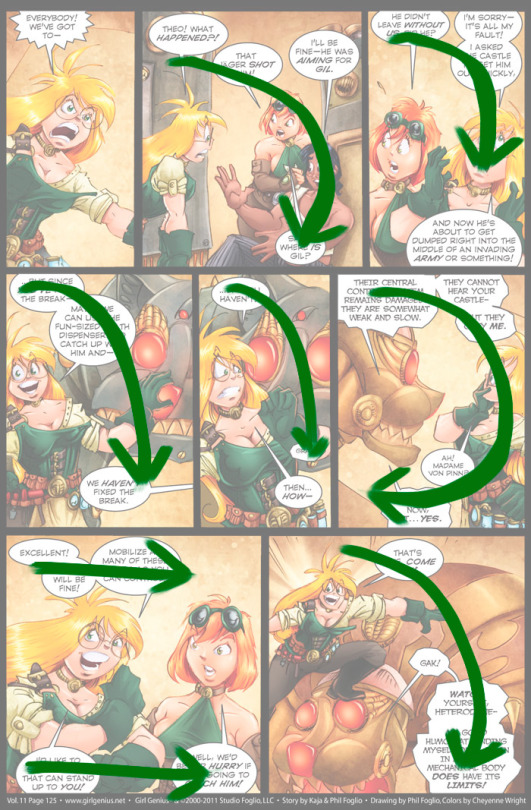
---Girl Genius
See? The speech balloons are positioned in a way it’d be easy for the reader’s eyes to move towards the right. The dialogue always starts on the top left corner and moves either in an arch towards the bottom right corner or in the top and bottom parts of each frame. It’s not a requirement to set your speech balloons this way, but it’ll certainly make it easier for the reader to read!
To put it in a nutshell: as a rule of thumb, remember to direct the balloons placement in a way that leads from left to right or from top to bottom.
Another thing you have to remember and keep in mind if what font you’ll use for your lettering. What kind of font would be the best for your dialogue? Any font that’s legible at small sizes will be good. Maybe Comic Sans would be your first thought because, just as its name says, it was created for comics, and that is because Comic Sans is meant to be readable at small sizes. That doesn’t mean you have to limit yourself to using Comic Sans. There are many other fonts that could be useful to you!
I recommend you take a look at this website. It has many fonts that can be used in the comic book industry, and most of them would be good for your webcomic, no matter the genre. Some are paid fonts, but there are many fonts that are free to use and can be useful to you.
Here, take a look at some fonts you could use! Compare and decide!
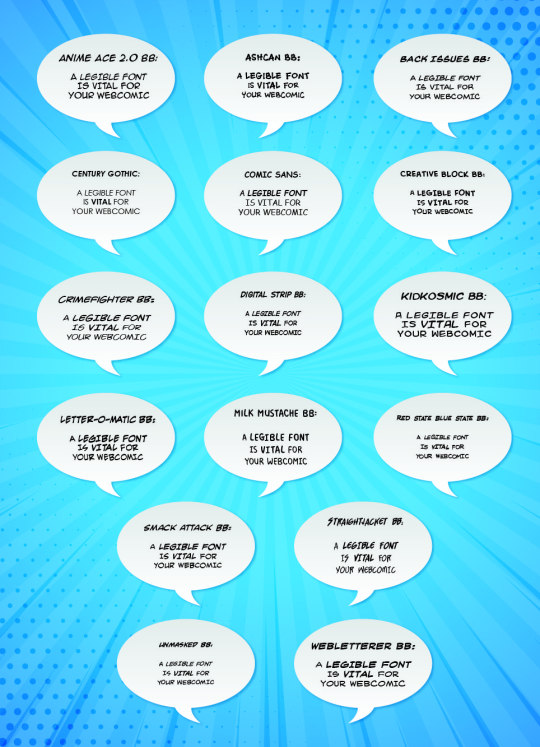
Personally, I like how the Back Issues font and the Kid Kosmic font look!
Generally, it’s recommended you use all-caps in the webcomic, as it’ll be easier to read. Most of the fonts you’ll find for comics often only have capital letters, so most of the time you just will have to type without worrying about activating the all-caps function.
I HAVE THE FONT AND THE IMAGE. NOW WHAT?
Open your sketch or finished image in your software of choice. For the purpose of this post, I’ll suppose you have Photoshop. Most software you can use for these purposes have the same basic functions, so it doesn’t really matter.
Create a new layer above your image. This layer will hold the speech bubble itself – the writing will go in a different layer. Don’t start drawing ellipses or circles yet! Instead, write the text you want to use, and place it where you want it to be, and the size you want it to be. If the text tool didn’t automatically create a layer when you used it, manually make a new layer and place the text there. It’s a good idea to have one layer for each speech bubble, don’t lump all speech bubbles in the same layer.
Once you have the text written, you can make the speech bubbles themselves! The quick option would be to use the ellipsis tool and fill it with white color, but the result will end being rather generic. How about you try to draw the speech balloon by yourself? Use a tablet or, if you don’t have one, use the pen tool. It may take some practice, but this should give your webcomic a more professional look.
You don’t have to make the balloons perfectly round. As long as it’s decently round and doesn’t look like something splattered all over your image, you’ll be okay.
Remember to leave some space around your text, though! Constricting your dialogue into a speech balloon smaller than it is not a good idea.
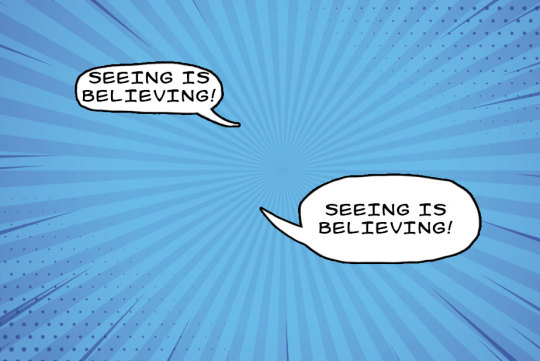
See?
Also, there’s a technique that could make this easier for you. In Photoshop, there’s a special layer effect called ‘stroke’. If you configure it correctly, everything you draw on that layer will be surrounded by an outline. Make sure to configure it so there’s a black border, of two or three pixels wide, and that it’ll be placed externally. Use a brush with a white color to make the speech bubbles, it’ll immediately be outlined, with no additional effort on your part! If you want to recreate these characteristics in new layers without having to open the window again, all you have to do is duplicate the layer while it’s empty. That’ll give the same characteristics to the copied layers!
Those are the basics of speech balloons.
Dialogue isn’t the only text you may use in a webcomic, though. There’s also expository dialogue, like a monologue, thoughts or notes you’re adding to the page, for one reason or another. What to do, then?
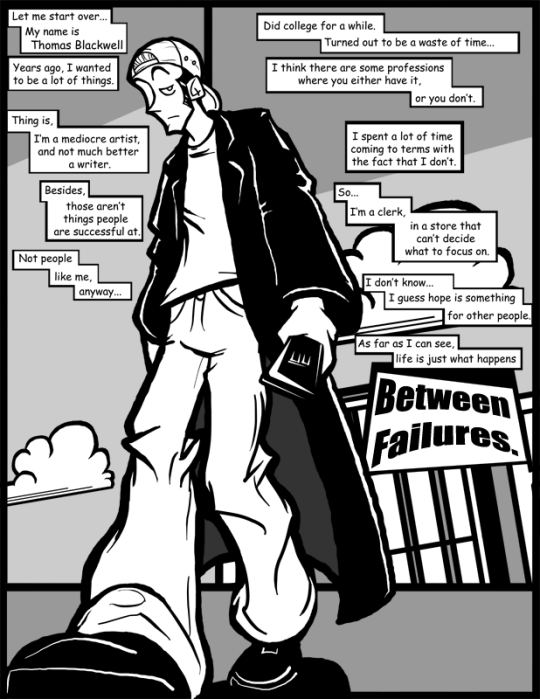
---Between Failures
Usually, these are done in these rectangular boxes. These could be considered similar to speech balloons in many ways, and follow many of the tips and rules speech balloons have. When asked, the author of Between Failures said this:
I've only done this two or three times in the entire run of the comic. It's not talking because it would make the character look insane if he monologued out loud to himself for a couple of pages. This is basically just expository narration to set up the premise of the comic in a single page.
How much expository narration is necessary for a webcomic? It’s not like there’s a definite answer to such question or a guideline you need to follow, but it may be worth remembering that webcomics are a visual medium. Sticking to the ‘show, don’t tell’ may be a good choice, since illustrating some of the exposition may help get it across better than text would, with the risk of breaking the pacing a bit. It all depends on the situation, so trust your intuition, ask yourself what you’d like to see!
I UNDERSTAND!
Excellent, I’m glad to hear that.
Oh, right, there’s one thing more you may want to hear about: can you stylize your speech balloons? Give them your own touch? By all means, go ahead! If you feel it’s appropriate for your webcomic and you think it looks good, then experiment all you want. Gauge how the speech balloons look in your webcomic, maybe ask for a few opinions...do everything you can so the end result is something you’re happy with.
It doesn’t have to be anything complicated. Simple measures such as a shadow or a border around your speech balloon can be quite effective to make your webcomic have a distinctive mark to make it stand out from the many, many webcomics available on the Internet.
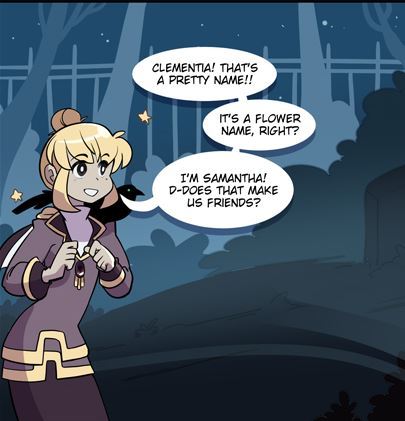
---Solstoria
I started adding them because I removed the black outline on the bubbles and felt they looked better with a drop shadow and now concrete outline. I also removed the outline of the comic panels of Solstoria in general around that time too! I just did it because I wanted to try something different and I liked how it looked. I know Solstoria isn't highly structured, but I enjoy experimenting with it.
As you can see, speech balloons aren’t something done spontaneously if you want professional results, but the effort will be worth it!
---
I hope everything discussed in this post is of some use to you. Good luck to all your endeavors in the field of webcomics!
9 notes
·
View notes
Text
Film friday, this will be replaced on Monday.
Twenty-five thousand years ago the cavepeople who did things the hard way—like, crossed rivers in the rapids rather than walk for an hour looking for the shallows, or hunted wooly mammoths solo with a knife rather than with ten other tribesmen all armed with spears—drowned or died, and didn’t pass on the genes that encouraged the hard-way ways.
The hard way stuff made sense when there weren’t options, but it’s normal to always find the easiest way to do whatever. Now the easy ways are almost but not quite the only options, and you have to try hard and avoid all of the world’s messages to get to the hard way. Still, sometimes the good thing to do is the hard thing is to do, even tho the easy way has its hooks in you.
There’s too much easy now, and when something got easy depends on what thing you’re talking about. In the post-WWII decades, the easy way to fix green beans was to open a can and turn a knob to turn on the range. All the baby boomers in the country grew up on canned foods unless they grew up on a farm. I never ate a fresh vegetable between my 1954 birth and about 1969, when I started doing all of my own cooking, and got curious about exotic raw vegetables.
Also after WWII, the easy way to kill bugs was pesticides. Their effects on other life was untested, and they were unregulated, and the only good thing that came from them came from them was this 1970 song:
youtube
The song wasn’t worth the destruction that had something to do with some of the lyrics, but at least it snuck in some digs with memorable lines heard by lots of kids who without the song, might have been environmentally clueless. Pesticides wiped our forests, song birds, salmon, raptors, and people. Not all easy ways are destructive, but the destructive side effect isn’t rare. Cars are the easy way to get around, and…I don’t need to recite the car-cons. The pros of cars benefit people only, and the cons affect people plus everything else.
Today is “Film Friday,” and the Hard/Easy discussion works for “image-making,” too. The first photograph was taken in 1839. It changed art. Up to the mid-to-late 1880s, most of the famous artists…and maybe even all artists who painted, painted realistically. But by the 1860s, photography had progressed to the point where photographs could out-perform any painter’s most realistic effort---although, only in black-and-white. So Monet and his group of impressionists painted different topics—outdoors, flowers, farms, ponds, farm ponds with flowers, plain people in plain scenes, and used bright colors (not black and white!) and short, imprecise strokes (the opposite of photographic realistic-ness). The art critics hated them, but they stuck it out, and long after the impressionists died, their paintings are probably the most loved of all paintings. It’s safe to say that if you don’t like impressionism, you are insane.
The art world grew and different styles came of it, and when there were no more obvious styles to develop, we got abstract artists like—who’s that guy with the paint buckets? I mean no disrespect, I just can’t remember his name. Bismarck? No, Marksteinberg? I can’t think, it’s late. You know the guy. He was influenced by the Beats in the ’50s. Maybe he was one of them, but he was late to the movement if he was. I’m NOT thinking of David Hockney. Not Roy Lichstenstein. I’m not sure of these spellings. The splattered paint dude, him. He would have been hung in France in 1859, but his paintings go for millions of dollars, even though there’s not a clear and obvious finely honed skill to the paint strokes, if that’s what they are. I have no quarrel, my point is just that everything is a reaction to everything near it, and that’s where this becomes Film Friday. Jackson Pollock!
The best and worst thing that’s happened to photography is the smart phone...which strictly isn’t photography, but it’s still an effective way to make images, if that’s not a stretch of “make.” If your phone catches fire, do the images go up in flames?
The point I’m taking a long time to get to is NOT that phonography is bad. I think it is fantastic! The point is, the look of phone pictures eventually wears you down, and at that point, even a bad black-and-white photograph (or scan of it) tends to be refreshing. After overdosing on perfect colors and everything so sharp in kind of unneccessary images often not well composed, a crappy black and white photo that remind you of the crummy ones of your childhood or your parents’ childhood...are refreshing. Black and white can be easier to look at, just like impressionistic paintings.
The instantness and ease of the cell phone image is hard to shake, but eventually it may wear thin, like eating too much candy, and when that happens, the fussiness and struggle with a film camera starts to seem fun. It’s natural to seek the easy ways, but not enough challenge leads to an imbalanced existence, and you have to re-balance. It’s a blast, seriously, to not know how to do something, or to get a lousy result. Lousy results are fantastic, and they’re all real and fun. If you’re good at everything immediately, you’re going to be sad. It feels great to struggle and be lousy at something, then squirm and claw your way out of that frustrating, failure-fraught hole.
The famous ancient photographers would have given up film in a second, and for exactly the same reasons, modern experienced photographers are doing the same thing. Nikon, Canon, Olympus, Minolta, Kodak, Mamiya, Rollei, Hasselblad, Bronica, Ricoh, and every other camera maker except MAYBE Leica, has quit making film cameras, which, I can say right here but not in public-public, means--to me--that they’ve quit making cameras. (Leica stillmakes one film camera, I think).
What they make are computers that look like cameras and that use the same lenses and have many of the same controls as cameras, that give you the “photographer” look while you’re operating a computer. Buddha bless the computers that look like cameras! But still, the stuff that goes on inside them is not like the stuff that goes on inside the cameras that your parents or grandparents used for photography.
What makes a camera a camera, and how is it different from a computer, and do we automatically stretch the definition of photography to include processes that use sensors and megapixels instead of shutters and chemistry? What makes a bicycle a bicycle? When does something stop actually being the thing it’s pretending to be and being marketed as? It’s all so fun to think about!
You don’t have to be richto take to film photography, but it helps to not be fighting off bullets. It IS harder, the results aren’t immediate, so the feedback is more deferred so it’s slower to learn, and with a fully manual camera you can’t just point and shoot. (You can’t buy a point and shoot camera anymore, and eventually digital images will be blinkable, so you won’t need a digit).
Kodak has quit making lots of its film. Fuji, too. Ilford still makes it all, and it’s cheap and good. There are places that develop it if you don’t do that yourself. You can get digital scans of your film images, so onlining them is easy, like this:

Roman shellacking. Bad focus (brush should be in focus!) but overall it’s still fine. Blurring the background makes it less distracting.
Will, Roman, Jenny, Dave, Vince, and I are taking more film pictures these days, and you’ll see them on the site in black and white, with all their flaws that make them stand out from phone pictures and make them look better for all of that.
There’s a 28-year old BMX-y guy named Travis Mortz. He is my hero. He shoots BMX with a chunky film camera, travels with his developing stuff, and has a million ultrafantastic videos romanticizing film and telling you good stuff. Google “Travis Mortz forest hill film lab videos” or something like that, and you’ll see ‘em.
He or Ilford or thedarkroom.com or Blue Moon in Portland, or Citizen Photo also in Portland, Photolab and The Looking Glass in Berkeley, or the Foresthill film lab (see the video at the bottom of this--that’s him)...or lots of places still do this stuff. Look them up in the Yellow Pages or the internet, whichever is easiest! There’s a place in Iowa that develop black-and-white SLIDE film--one of like seven places in the world that do that. There’s so much stuff out there, and it’s not inconsistent to use the internet to find out where they are.
You can get a used 35mm film camera and lens for $100 on eBay or from KEH camera...or Blue Moon...lots of places. You can get ‘em for less than $50, even. Film costs $6.00 for a roll of 35. It costs $16 or so to develop it and get back scans. You can monkey with them in photoshop. You can get digital prints or real prints (optical).
There has never been a better-cheaper time to get a film camera and get into genuine photography. Used film cameras are so underpriced now. What would have cost $5,000 in 1990 new now costs $600 used in great condition---or less! And if you bail out on film you’ll be able to sell it on eBay for 80 percent of what you bought it for.

This is my favorite RIV-picture, and I got it with an Olympus OM-1, Ilford HP5 film, I forget the lens. At least 11 shades of gray in the packing paper.

My dog Scoutie and wife Mary on a hike near the house.

This is with super grainy film, and is one of my favorites.
And below are pix from others here—Dave, Jenny, Roman, and Will—for a refreshing change...

Dave: end-of-roll double exposure of my favorite wife, cat and guitar.

Dave: first pic I shot when I dusted off the Pentax for this film renaissance. My bike in front of a food cart. Very busy.

Dave: I like happy accidents. Like when only the wheel is in focus here.

Dave: Berkeley skate park.

Dave: Trying to fill the frame with business.

jenny-- commute home, Sacramento

employee parking outside of #20m my (shipping) room. maybe 105 degrees this day.

SF giants home game

jenny homer riding from vancouver, WA to portland, OR during Rivelo weekend in June.

jenny neighborhood, sacramento

Roman loves to take “extra-credit” trails off to the side of the fire-road. Here’s a fun one in Shell Ridge. Cowboy hats make any picture better. Bandanas too. -will

On the way to camp. -will

Willy from the same ride as the one above. -Roman

The Yuba River shot on a Yashica T4 -Roman

Our man Manny -Roman
youtube
I completely dig this guy, Travis Mortz He’s 28, going on 78. He loves film, shoots BMX with a Hasselblad cameras (it’s not the easy way), and if far more experienced and by far a better spokesguy for film than I am. His videos are a joy.— Grant
last thing: If you live in NYC and want to see the best photographs in the universe for free, go to 64 Grand Street (the same one referenced below). I’ve been there four times, and it’s life-changing!
Now the bricks lay on Grand Street, where the neon madmen climb,
They all fall there so perfectly, it all seems so well-timed
But here I sit so patiently, waiting to find out what price
You have to pay to get out of going thru all these things twice.
—Bob Dylan
15 notes
·
View notes
Note
Hello, yes, hi, I recently found your art and account and I love what you do. I'm turning 14 in April and I've asked for a drawing pad, but I have no idea how to use one as of yet. Have you got any tips or anything? Because I've wanted to try digital art for a while and your art makes me want to even more lmao. Thanks! - B.A.
BOI OH BOI DO I GOT SOME TIPS FOR U
(I’m not sure what kind of comp you’re going to be using, so I’ll list for both.)
FIRST: Drawing Programs; the free and the great.
-Firealpaca: Lightweight drawing program. I draw Recovery using this! It’s easy on the RAM if you have a weak comp/are paranoid about yours like I am, it is mainly for basic comic making, and has all the basic brushes you need (pen/pencil/airbrush/symmetry/etc). You can add your own brushes as well but they’re p basic settings. Has basic Animation/Gif making as well using Onion Mode! Layout is a piece of cake. Please note that If you leave it open for a week it’ll crash on you, even if you haven’t anything on it at the moment, and sometimes the brush sensitivity just stops working so you just have to close and then open it again. (Also I have no idea how to update it aside from deleting it completely and just downloading the new version from scratch, so thats a thing.) Mac/Windows
-MedibangPaint: This is basically FireAlpaca But Better. Has tons of screen tones, brush patterns, and tools. I don’t use it much because I’m used to FA’s layout and get confused with the the placement of tools in here, so if you can I highly suggest just going with this first. Also has basic animation/gif making! Has storage for the website as well, and you can upload more preset brushes. It’s v anime. This program has waaay more in terms of basically everything, so it just takes more RAM. NBD, you don’t have to have every brush downloaded from the storage ^u^. Mac/Windows
-Clip Studio Paint: Okay this one isn’t free, it’s a pricey one, HOWEVER once a year they take the price way fuckin down by at least 75%. Sign up for the email list and it’ll let you know when that precious day comes. It’s how I got it @u@, around christmastime? This program is basically MedibangPaint On Steroids. I do all of my digital-yet-tradition-style-painting on here! The brushes all have some neat af settings to play with, you can make your own brushes, has tons of screen tones, pre-made panels, and settings. You can save projects as basically anything you need, is a hardy program that almost never crashes, and It’ll take a nice chunk of space on your comp depending on how much memory you have but hey, its worth it. It’s much more complex layout-wise than the other two here, but you get used to it after playing around and watching tutorials haha.
-Mischief: It’s a 25$ app, has like four brushes and five layers only but is vector-based with an endless canvas. Not really worth having unless you like the vector thing. UP TO YOU. I spent forever with this one doing all that homestuck stuff, so it’s not really bad so much as it is a basic bitch. Mac
-MyPaint: I used this a bunch when I still did digital art on my windows laptop before I upgraded to a Mac. It’s easy on the comp and has plenty of brushes and settings. You can also get brush packages if you don’t feel like you have enough that comes with the program! Also has endless canvas; pretty sure you can just select an area and then export as is. I barely remember the rest but It’s pretty great. Windows/MacPorts(which I hate)
-GIMP: I hate this thing. I cannot figure it out for the life of me. It’s got loads of shit though, can handle layers, has plenty of brushes, and can do basic animation/gifs if you ever figure it out. Windows/mac
I’ve heard good things from paint tool SAI and Krita as well, but have never used them myself.
***You can always pay through the nose/use a student discount for the photoshop series and pay that shit monthly, those fuckers have literally everything, but I am a cheap college kid making minimum wage with a car payment; I’d rather just pay once/not at all.
TABLETS: treat that shit like a newborn babe 24/7
-I have literally only ever owned a Wacom Intuos4. It has lasted me six years, and at least five moves across many miles. I broke one of the cord ports the day I opened it by holding it wrong, have one left, and now treat it like it’s going to die if the cord moves badly. Please be aware that if you break both ports, you better either sodder it back together yourself or upgrade to smth else because it costs about as much as the tablet itself was bought at to be fixed. Good news, though, it comes with at least six extra pen nibs, has programable buttons on the side (that I have never bothered to use) and a scroll bar in case you’re too lazy to use the keyboard (…I don’t really use that either unless I’m just scrolling through tumblr LMFAO).
-I would die for a Cintiq.
HOT TIPS: its useful.
-most of the programs listed use the same keyboard shortcuts. MEMORIZE THEM. It’s pretty easy, since you’ll use em a lot. [cntrl/cmmd+T] lets you resize what you just drew on that layer, and [cntrl/cmmd+z] is undo. I use those the most, for obvious reasons.
-vector-based programs are pretty great because when you resize an image it looks prefect. You can’t do that with a program that isn’t, so I just resize the base roughdraft and draw the lineart again on the layer above so I don’t get weird JPEG quality lines.
-You can use a ruler with your tablet, just slap it on and go, but honestly most programs have settings for that. just use those.
-You can also trace stuff on your tablet, so long as the paper isn’t too thick. I just scan/take a photo and then open it up in the program, though. much easier.
-SAVE CONSTANTLY. Art programs like to crash on you, even when they’re hardy and you have a good comp. make it a habit to quick save your work.
-Use a desk and have good posture. You’ll be able to draw a hell of a lot longer if you do. I personally keep fucking up my knees by sitting on my legs as I work out of habit, and don’t actually have a desk chair. Keep your screen at eye level and at a fair distance to prevent eyestrain and also neck-strain haha
-Chances are you won’t be used to the tablet right away. Most places you buy from say it’ll take a couple of months to get used to how weird it is to draw while not looking at your own hand, so don’t be frustrated If your drawings look a bit off at first.
-if you draw at least one thing every day, by the end of the year you’ll have improved exponentially. I literally made this blog to make myself draw once a day.
-don’t be afraid to check out speedpaints and tutorials. It’s always good to get more familiar with the program you’re using and new techniques previously unconsidered.
-get familiar with clipping layers. They are insanely useful; you clip one layer to the one below and then when you draw it only shows up on the drawing of that layer below. Shit is a godsend if you’re bad at coloring in the lines/lazy. The bucket tool is also really useful, and you can adjust the expansion by pixel so you don’t miss anything between the lines.
-experiment with your brushes, shit be fun af
-warmup your wrists before and after drawing. prevent swollen veins and such. dont want hand pain/numbness, its reaaaaally bad.
—basically if your hands hurt stop for the day.
-PNGS are for internet, JPEGS are for printing/fucking with quality (cough hack homestuck)
-resolution doesn’t have to be much more than 350 dpi if its just going to be on a webpage. Maximize that shit if you’re going to be printing, though. Especially if you put stuff on redbubble.
-DeviantArt has this thing called Sta.sh where you can dump art, keep it in perfect quality and just share it with certain people with a link instead of all of the website. Great for storing commission pieces, its the only reason I have DA in the first place.
-you get a different audience depending on what site you use for posting art, so keep that in mind for the kind of feedback you want.
-after awhile of drawing using a tablet, you may lose patience/forget that in traditional art there isn’t an undo button lmfao It’s cool; you don’t have to choose one over the other or anything.
-Honestly you can work around almost anything. You just invent new ways and techniques for yourself and you’ll do just fine.
Aaaaand that’s all I got for today! Thanks for sticking around
277 notes
·
View notes
Photo
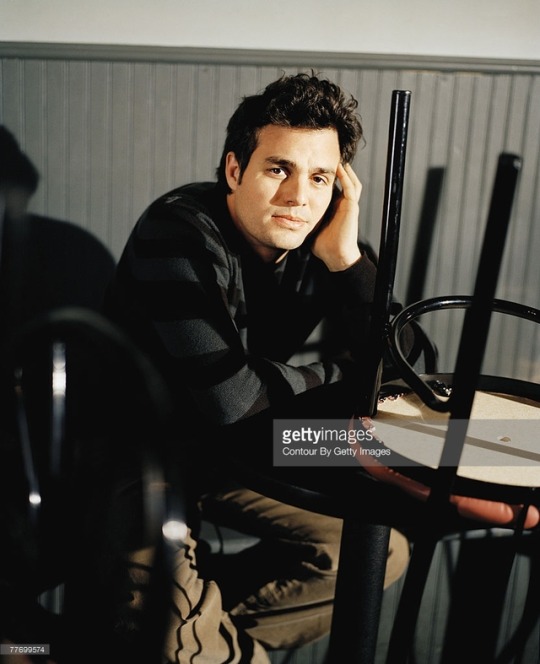
This article is a perfect example of the kind of expectations those of us who were blown away by Mark Ruffalo’s performance in “You Can Count on Me” had for him and his career. Those expectations are still there for many of us, waiting to be fulfilled by directors willing to take a chance on Ruffalo, and willing to push him to his limits. - Jamaica (FrustratedCastingDirector)
Becoming a Thoughtful Woman's Idea of A Leading Man Part 1
By CATHY HORYN NOV. 9, 2003
On a cloudless day between the rains this summer, Mark Ruffalo, the 35-year-old actor, took his John Deere tractor out of the barn and began to clear brush on his 50 acres in Sullivan County, not far from where the Delaware River runs between New York and Pennsylvania. He had on jeans and a faded blue shirt that flapped around his thin torso, and his hair was still damp from a swim in the pond that lies at the foot of a grassy hill and a short walk from his two-story Swiss chalet-style house. A patio umbrella and several weathered lawn chairs were set up along the edge, and there was a dock with a wooden diving board that Ruffalo and his younger brother, Scott, a hairdresser in Beverly Hills, built last summer. When the brothers were growing up in Kenosha, Wis., they built many tree houses in the woods near their family's house -- Scott guesses they built one every 10 feet -- and they called themselves the Foresters. Two years ago, when Mark was recovering from surgery to remove a benign tumor in his brain, and thinking that his film career had ended just as it was taking off with his widely praised performance in ''You Can Count on Me,'' he designed the large sleeping porch at the back of the house. Constructed from hemlock, with open beams, it has double-high screened windows, many comfortable old chairs and beds and a closeness with the outdoors.
As Ruffalo positioned the tractor on the far end of the pond, his wife of four years, Sunrise Coigney, a lithe, attractive French woman in a bikini and a straw hat, sat on a blanket near the dock with their 2-year-old son, Keen. Her father, Joel Coigney, who was visiting from Los Angeles, had spent the morning policing the grounds with a chain saw and now joined Ruffalo on the hill. In a moment of perception that took in their voices, the water and the valley below, you couldn't help thinking that Ruffalo had everything he needed here and that there was no place he'd rather be than here.
It was also the perfect place to observe Mark Ruffalo the actor, for few performers possess their characters with more natural grace. Not only does Ruffalo make it look easy, he also manages to access emotions with a freedom unavailable to many of his better-known contemporaries, making him closer to the older generation of actors -- especially the young Brando -- for whom anger or sexual tension could often be registered with astonishing stillness. That Ruffalo has appeared in only a handful of big-budget films, usually in supporting roles that have limited him to playing the same type of emotionally conflicted men -- and thus kept his real powers under wraps -- has not prevented him from being noticed by first-rate directors like Jane Campion. But after the release of Campion's heated sexual drama, ''In the Cut,'' co-starring Meg Ryan, followed soon by films in which he stars with Jim Carrey and Tom Cruise, Ruffalo is certain to find a wider audience.
''In the Cut'' is based on the novel by Susanna Moore, and despite its problems as a film, Ruffalo, as a New York City homicide detective named Malloy, stands out. On every level his performance is a major turn-on, and maybe because, for the first time, we are seeing him as a man -- without conflicts, without boyish tics. In a bedroom scene early in the movie (slightly altered by the censors from the director's version), Ruffalo takes Ryan's character, Frannie, on such a bend, using every word and orifice available to him, that many female moviegoers will most likely regard their own mates with mild disappointment.
Given Ruffalo's previous screen roles, Campion admits he wasn't an obvious choice to play Malloy, who looks at every woman as a potential score. But, she says, ''the thing that interested me about his character in 'You Can Count on Me' was that he was such a flake-off, a loser, yet he was riveting. You couldn't stop watching him.'' In ''In the Cut,'' which takes its name from street slang for sexual intercourse, his presence is so commanding that it can make you forget the film's flaws, notably its jarring end. ''I think it's incontestable now that he has brought to life a different quality of performance,'' Campion says. ''And not like Pacino, or De Niro or Keitel, who have each opened up a new way to think about performance. Mark is a visionary with his work.''
Ruffalo seems genuinely surprised by her comments when I see him in Sullivan County. By then, we are fairly along in our conversation, so I am used to his way of speaking. He does more than look you in the eye. He quickly establishes intimacy by allowing himself to lower his guard. Many actors will let you know, directly or indirectly, that they have nothing riding on the outcome of a situation. But Ruffalo has no such obstructions. He is lightning present in the conversation. And though he has little in common with the characters he has played, if he is close to one of them, it is Malloy. Like him, Ruffalo doesn't hide his manliness under a bushel.
''I don't know what to say about that, babe,'' he says when I tell him what Campion said. He laughs, and his eyes glow with warmth. ''That's flattering. I mean, what do you say? Thank you, thank you, Jane Campion.''
While Ruffalo readily cites Brando as one of his two greatest influences (the other is Marcello Mastroianni, of whom he says, ''It's the whole package of Marcello -- the great life in an art form''), he seems uncomfortable being compared with a legend. Kenneth Lonergan, who directed Ruffalo in ''You Can Count on Me,'' says he should relax. ''First of all, he looks a teeny bit like Brando,'' Lonergan says. ''And I'm sure he can't mind too much if people compare him to one of the greatest American actors of the last 50 years.'' Ruffalo does bear a resemblance to the young Brando, especially around the mouth, but the real point of reference, Lonergan says, is how specific Ruffalo's performances are and how freely he enters and remains in the moment. ''He's sort of an open channel to his characters,'' he says.
The question is why we haven't seen more of Ruffalo before. He began acting in 1989 in small theater productions in Los Angeles. His parents, a painting contractor and a beautician, had moved Mark and his three siblings (he has two younger sisters) from Kenosha to Virginia Beach, Va., where Mark would become a state wrestling champion in high school, and then to San Diego, where his parents separated. After an aimless period spent mostly surfing, Ruffalo enrolled in the Stella Adler Academy, where Benicio Del Toro was a star pupil. He remembers Del Toro giving a monologue based on the song ''Light My Fire'': ''He was so sexy and had so much charisma, I thought, I'll never be that.''
In those years, Ruffalo says, ''it was all about urban for me.'' He lived in rough neighborhoods like Alvarado and Sixth, in downtown Los Angeles. But as much as he hankered for that kind of experience, and brings a similar instinct to his work, he is no fan of Method. ''Two things have happened to acting in America,'' he says. ''One is that actors think they have to live the character, which is a huge mistake. Because what they do is put the character on top of themselves and thereby kill anything spontaneous. The other is that someone introduced the idea that less is more, so that actors stopped doing anything at all. They just say the words.''
By the mid-90's, Ruffalo had appeared in some 30 plays, earning good notices. But Los Angeles theater, at its best, is not Broadway, or even Off Broadway, as Ruffalo discovered when he arrived in New York for the first time. ''I thought, I'm a swan, not a duck,'' he says. ''What am I doing in Los Angeles? I don't belong there.'' In 1996, after a decade in California, Ruffalo made his New York stage debut in Lonergan's ''This Is Our Youth.'' ''He did one play in New York,'' says his friend the actor Christopher Thornton, ''and it changed his life.'' It wasn't the only change. On a Monday during the play's run, he took his savings, about $10,000, and made a down payment on a house in Sullivan County.
Another explanation for Ruffalo's belated recognition involves the vagaries of Hollywood casting. Ruffalo estimates that before he landed the part of Terry in ''You Can Count on Me,'' opposite Laura Linney, he went on 800 film and television auditions. This is probably not a Hollywood record for rejection, though Ruffalo gives it some comic perspective when I observe that George Clooney remained under the noses of casting directors for years before someone realized what a leading man he was. ''If George Clooney was under their noses, then I was, like, under their knees,'' he says with a laugh. For all his dead-ending, Ruffalo sounds remarkably unembittered when he adds, ''In Hollywood, none of those people can make a decision. They can only say no. I'd go to casting directors, and they'd say, 'You are the best actor of your generation, but -- you just haven't grown into your face yet, your face hasn't grown into your soul.' I had insane things like that said to me all the time. 'You are one of the greatest actors I have ever seen, but -- .' I'd get this great feedback, but I could never get a job.''
Still another explanation is that, in the summer of 2001, as he was finishing ''The Last Castle,'' a prison movie starring Robert Redford, the brain tumor was diagnosed. He underwent a 10-hour operation, complicated by an allergic reaction to the anesthesia, and spent the rest of the year recovering in New York and Sullivan County. His wife, whom he met in 1997 when she was an actress, had just given birth to their son, and as Coigney told me, ''You don't expect a year into a marriage -- through sickness and health -- for sickness to come upon you so quickly. It's been quite a journey.'' He experienced facial paralysis, memory lapses and, perhaps worst of all, a complete loss of confidence. ''I had stopped worrying -- I just believed that my career was over,'' he says. ''No one would take a meeting with me or anything. I was damaged goods, babe. That's what was in the back of my mind, damaged goods. Can't fit the American-male leading hero. A hero does not have a brain tumor.''
It was in this vulnerable, if fully recovered, state that Ruffalo first met Jane Campion in Los Angeles to discuss the part of Detective Malloy.
Anyone who has read Susanna Moore's 1995 novel has no trouble recognizing its difficulties as a movie. For one thing, ''In the Cut'' deals with female grief and loneliness -- specifically, that of a smart, emotionally walled-off writing teacher whose obsession with language serves as a rendering of her engulfed spirit; she's so aware of the shape of her consciousness that she could diagram it like a sentence. And for another, you don't really buy the sexual liaison with the cop, which develops as he investigates a gruesome murder in her neighborhood. As Moore herself says: ''The book is a little cold, a little nasty, a little flippant. It's about language and ideas. And it's not about love. It's about violence. But Jane found a way to make it about love.''
Ruffalo says he had serious doubts going into his meeting with Campion about his ability to play Malloy. ''I had read the script a couple of days before, and I thought, I don't even know where to begin with this guy,'' he says. ''I know he's just a man, he's such a man. But I had never played that kind of guy, and it just terrified me. I thought, I'm the wrong actor for this part.'' Who did he think was right? ''Sean Penn or Russell Crowe -- tough guys, you know. Guys who were really closer to Malloy than me.'' Indeed, as Moore conceived him, Malloy is actually a composite of four or five New York policemen she met while writing her book. She says: ''They were worldly, tough, a little bit over the hill. Much less pure than Mark. They were corrupt emotionally and, in some cases, corrupt professionally.'' In her mind, she saw ''an older Tommy Lee Jones, puffy eyes, a little flabby. Mark was quite an unexpected choice.''
At the end of the three-hour meeting, Campion, who had seen several big-name actors, offered the part to Ruffalo. ''We just clicked,'' he says. ''Jane's ideas about the script were well formed, but she was confident and experienced enough as a director to allow a discussion to take place. A lot of our differences about the character were just semantics.'' Despite his trepidations, he says, ''I had never come to a part so consciously aware of what we were after, down to specifics like what Malloy did when he woke up in the morning.''
One thing that may have allowed Ruffalo to reach Malloy is his penchant for severe self-criticism. Christopher Thornton says: ''He attacks himself harder than anyone. In 'In the Cut,' he used those worries and fears. Everything that Mark was going through I'm sure in some way fueled that performance.'' During rehearsals, when he was still unused to Campion's intensity -- ''She's out there, man,'' he says. ''It's a contained chaos'' -- Ruffalo went home and got drunk. ''Jane and I had some bristling experiences in the beginning,'' he says. ''There's an enormous allowance for people to be wrong in her presence, even her. But the great thing about her is she's not invested with being right.
''So I was wasted drunk, really depressed, and I set up the video camera,'' he continues. ''I was, like, I don't know what I'm doing, I'm totally lost. . . . A couple of days later I was logging something from the tape and I saw it -- I saw Malloy, a shadow of Malloy. My tearing apart and hitting rock bottom was kind of like the birth of him.''
In the genre of police movies, Ruffalo's portrayal of Malloy seems startlingly realistic -- how you imagine detectives to stand and smoke and put their hands in their pockets but rarely do in the movies. There is a scene quite early in the film, when Frannie encounters Malloy and his partner, Rodriguez (Nick Damici), in a bar, that is almost unbearable to watch for its vulgarity. Ruffalo doesn't just talk in the unholy language of cops; he projects the psychological dynamic in keeping emotions at a distance. Campion, ever alert to the tiniest sign of weakness in Malloy, occasionally caught him, he says, reverting to old habits. ''She would say: 'You see that thing you're doing right there? Don't do that in this movie. Don't nod your head. No apologies, Mark. This character does not apologize. Straightforward stillness.' She made me aware of things. Who calls you on your stuff?''
The film's reviews have been mixed (though Ruffalo has been held out as its strongest element), but critics and box-office results aside, no one knows better than Ruffalo what the film -- and Campion -- have done for him. ''What I do in the next 5, 10 years will be mostly based on my choices,'' he told me. ''And it starts now. It wasn't after 'You Can Count on Me.' '' He's at work this fall as an undercover agent in Michael Mann's thriller ''Collateral,'' with Tom Cruise and Jamie Foxx, about a killer who lures a cabby on a shooting spree. Next year, he'll appear in ''Eternal Sunshine of the Spotless Mind,'' a comedy written by Charlie Kaufman and starring Jim Carrey and Kate Winslet, in which Ruffalo plays a lab technician operating a memory-erasing machine. ''It was sort of a chance to play light and stupid,'' he says with a laugh, adding, ''Jane'll kill me when she sees it.'' On Campion's advice, he also did John Curran's drama ''We Don't Live Here Anymore,'' with Naomi Watts and Laura Dern, about the divisive nature of marriage. And sometime next spring, he'll direct Thornton in a dark comedy called ''Sympathy for Delicious,'' from a screenplay Thornton wrote, about a self-centered paraplegic who acquires the gift of healing but can't heal himself. ''He basically starts Healapalooza, where he's healing people in the mosh pit,'' Ruffalo says. ''It's kind of an allegory about fame.''
You sense that Ruffalo has used his craft profitably enough over the last decade not to feel he has to make up for lost time. He turned down the role of Brick in the current Broadway revival of ''Cat on a Hot Tin Roof'' in order to return to L.A., where his wife has opened a store with a friend to sell jewelry and decorative objects. And Scott Ruffalo notes with pride and dismay that his movie-star brother still drives around in a white 1974 Volkswagen camper. ''He loves that thing,'' Scott says, adding, ''There's almost this essence of obliviousness going on around him.''
I know what he means. During my visit to Sullivan County, I casually mention that Ruffalo is probably not yet in a position to think about massive fame. He looks at me critically and smiles. ''When will I ever think about that?'' he says. ''What will my thoughts possibly be?''
Still, the rest of us can't help watching. Susanna Moore told me recently that female friends of hers are already having dreams about him. ''Isn't it interesting,'' she muses, ''to be witness to someone who is absolutely on the edge of being hurtled into a greater and, in some ways, less lovely world? He's going to be a very important actor. He's just now tipping into fame and riches and women chasing him. I think he'll be O.K.''
36 notes
·
View notes
Photo

Immortal Flames vs. House De’bayle: Part II
Log Date: 1/31/17
OOC Note: The text in these logs are strictly for the readers enjoyment. Anyone using the knowledge displayed within this text without the participants knowledge risks the potential of blacklisting from future communication and roleplay. Please do not meta-game!
Tags: @halone-from-the-otherside
After Claire retired for the evening, new idea’s in mind for her brooch, it seemed others did not share quite the same enthusiasm as I had. Noticing Armont’s brooding mood, he finally spoke up on his heavy heart…
Armont De'bayle took in a deep breath before slouching into the couch “It would seem mine life is built for fighting Dragons, and not much more.” He sighed out, closing his eyes in thought.
Carina Roussos stands up from her seat in the kitchen, moving around to rest a hand to the man’s arm. “Armont… that isn’t true. There were so many things to consider during these spars. They were far heavier in armour compared to you, and you were unable to use your aether, something crucial for a Dragoon.”
Armont De'bayle looked to Carina with a pained expression, though was quickly removed with another deep breath. “A spear can only play in your advantage with distance between the holder and his foe. Once that gap is bridged ones life is forfeit. I must rely on Aether to best those whom I fight against, but that is not natural strength.” He gritted his teeth. “I have a style of fighting far different then most have seen or heard, but it is one that depends on Aether heavily.”
Carina Roussos hums out some, rubbing a hand to her husband’s arm, “perhaps you should expand your arsenal? Pick up more weapons?”
Armont De'bayle wiped a hand over his face. “I need to… sooner than later. Of all the weapons I am trained to use, none are as agile as a spear when flight comes into play, but none are as crippling.”
Carina Roussos: “Training yourself in other forms of combat will benefit you greatly,” Carina sat down beside him, resting a supportive hand to his knee, “what did you have in mind?”
Armont De'bayle: “I simply do not know. Perhaps the bow, but it is the same as the spear… I feel as if the sword and shield would best suite me. Would still be able to leap as I normally do, but not to its normal duration.”
Carina Roussos: “I mean there are no limitations to what you are able to learn Armont. I think you may benefit just yet from perhaps doing both? I have some training with a sword and shield so I can practice with you.”
Armont De'bayle: “All of the De'bayles are trained to wield all weapons that Ishgard had to offer at the time, but it has been some time since I last held it for practice or combat.” He let out a huff of air from his nose, calming down some as he looked to his wife. “I would appreciate that. Denz’s win or loss, you are still the victor and best combatant our House has.”
Carina Roussos smiles gently, “and you are strong in your art, but perhaps it is time to expand. I think perhaps when we visit Hito, that he can help you as well.”
Armont De'bayle: “I think our visit to him is long overdue. Aye.”
Carina Roussos: “Soon… I just…” Carina purses her lips, shaking off the thought, “maybe he can teach you to be a Samurai?”
Armont De'bayle canted his head to the side in question. “Samurai? What is that?” He asked curiously.
Carina Roussos clasps her hands together, “well… where he is from, they wield these long swords known as katanas. I am also certain they reside from the Far East. A very disciplined teaching, Hito is quite set on his teachings.”
Armont De'bayle: “A long sword? A single sword?” he tapped a finger to his chin. “I assume they are agile yes? Holding a singular sword without a shield sounds like a nimble art. You said these teachings also exist in our realm, to the far east. I wonder if Shirayuri or even your father would have further information on the art and history.” He chuckled, looking to Carina before placing a hand on her lap. “You are Doman too, so I would take your word over theirs.”
Carina Roussos: “They may, I know the world of Vana'diel and the world of Eorzea are not quite so different. There are even Dragoons there.”
Armont De'bayle reached forward to fill Carina’s cup of tea before pouring himself a small cup. Taking a small pull from it, he’d look back to her eyes. “Tell me more about ‘Vana'diel’? I know you have mentioned there are similar races, but are there any that are not in ours? You must understand that the thought of another world is enough to drive someone mad, but I am curious to hear more from it.”
Carina Roussos smiles some, “even talking about it to someone who has never seen it, who could not comprehend it, could drive someone to insanity. The Au Ra do not exist there, female Roe’s do not exist there, male Miqo'te are like myths. Slaves to the females. It is… interesting, to say the least. How similar and yet how different our worlds are.”
Armont De'bayle squeezed her leg playfully with a cheerful toothy smile. “You have not brought me to insanity yet. Maybe you have beat that out of me?” He winked, bringing a finger out to poke her nose softly. “What are your plans for tomorrow? Or rather, what is on your agenda, my lady.”
Carina Roussos: “Maybe you’re already there and you have yet to realize it!” she smirked, reaching over to give his nose a gentle flick back, “I am not quite sure yet. Plenty of work I am sure, why did you have something in mind?”
Armont De'bayle: “I say we should pay Jancis a visit, if that is not in the realm of possibilities, then we shall venture out into the Shroud with swords in hand.” He smirked, brushing his tickled nose some. “Do you prefer Lady De'bayle or shall I refer to you as my mentor?”
Carina Roussos: “From you? I quite like 'Carina’…” she smiles some, glancing into his eye, “I would like to visit Jancis… she has often taken care of me when I needed her, I wish to do the same. As for venturing into the Shroud, we will see how much daylight is left to spare for such an expedition, hm?”
Armont De'bayle: “I suppose so! And I admit, I do like Carina a lot.” He chuckled… mostly to himself. “I know we just gave Denz a basket, but we should come with soup for her. Hestia should come too. She does like tending to others just as her mother does.”
Carina Roussos: “Soup might be nice, or sweets! I know she likes sweets…. Hestia has drawn her plenty of her pictures.”
Armont De'bayle: “We could bring both. Something savory, and sweet. Hestia can drown her in toys as well. 'It help’.”
Carina Roussos: “It does help! I can vouch for this, I feel far more comfy with all of her stuffed toys snuggling me,” Carina laughs.
Armont De'bayle: “Did you feel better after drinking the medicine you had prepared?”
Carina Roussos shrugs, “considering how many times I have been sick in my life, it certainly wasn’t the first time. And I doubt it will be the last,” she smiles.
Armont De'bayle: “It has been long since I have last been sick… though if we are venturing out to Ala Mhigo, I might contract something there. Dust and dry heat have never been allies of mine…”
Carina Roussos: “Potentially, new and foreign lands with foreign germs tend to do that. I will have to be ready to prepare medicine when there…” she murmurs out, tapping a finger to her lip before blinking toward him, “are you anticipating travelling to Ala Mhigo?”
Armont De'bayle: “I feel as ifwe will be forced to if this war is ignited. We cannot simply hold ground. As a whole we must push those who oppose us, less we wish to be trampled by them.”
Carina Roussos nods, “I would have to agree… unfortunately. Hopefully this venture into new land doesn’t prove to be nothing but war.”
Armont De'bayle sat back into the couch again. “Wartime is never pleasant… and to think Ishgard has just ended the Dragonsong War… and yet we plunge into a new one. It is depressing to say the least, but we are sworn to serve in defense of Eorzea.”
Carina Roussos sighs, “I just… wonder what we should do with Hestia…”
Armont De'bayle: “Continue on. I promise you she will not change too much. I was born and raised in wartime… at least she has far more hope of this one not lasting a thousand years.”
Carina Roussos: “I can only hope so. Would we bring her with us?”
Armont De'bayle: “If the area is safe enough, aye, we will take her. If not we will operate out of Gridania as planned. Would you not agree?”
Carina Roussos nods, bringing a hand up to her mouth to yawn some, “maybe she will enjoy adventuring, after all I am sure we along with the rest of the House will be there ensure her safety.”
Armont De'bayle would reach up to pull the eyepatch off of his face and place it on the table. “Aye. As you have seen tonight, we have quite the talented group.”
Carina Roussos: “I have faith in them…” she smile, leaning into her chair comfortably, “it’s getting late.”
Armont De'bayle nodded. “I agree… I will check on Hestia before I join you in bed. She will likely be out like a rock as usual.”
Laying in bed that night, I truly wondered if Hito would teach Armont. If he would even want to see me. I wondered… if I wanted to see him. If I wanted to bring those memories and feeling back again. Glancing over to my sleeping husband, I brought my hand to rest within his larger one.
Armont treated me with far more kindness than I deserved.
5 notes
·
View notes
Text
This is a little political but please open a debate, this an important topic
Violence.
Violence is everywhere in American culture. Its so prominent in our every day lives that one could say we as humans almost seem to crave some sort of violence. From violent movies featuring idolized super heroes literally getting their head cut off or gunning through hordes of unnamed faceless goons, to video games where an entire feature is that you can murder random people in a number of whacky ways, to novels which have been around far far longer than either of my previous points that contain violence of some kind.
Now. Is it an insane assumption to connect the dots and believe that the crime rate and mass murder rate is directly affected by these forms of media? No. It makes sense with ver little thought required. I see violence; I want to emulate violence.
Now heres where i interject and propose this radical new idea that can be applied to more than violence.
Perhaps we crave violent media because it is a moral, ethical, and guilt free way to feel empowered. To scratch an itch. Some would turn away, deeply disturbed, from Grand Theft Auto's realistic environment inwhich you have the option to mow people down in any kind of car you can think of only to murder droves and droves of cops. GTA is a low hanging fruit but it sends the message. Its disturbing. Outright morbid. The things you CAN do are truly vile and no person should ever wish to do them in a real world setting.
You're driving to work. You cant find your keys and so you cant brush your teeth or eat or really get cosy before commuting to work. You're already a little disgruntled. Its a hot summer day and the steering wheel is too hot to touch and the car seat is sticking to you and no matter how hard you crank it the AC just wont give anything. Then you pull out... and into a mile of traffic. Traffic so bad the radio is talking about how they pitty you if you're heading to work. You get to work an hour late. You're hot. You're tired. You dont want to be here. Your boss chews you up and spits you out. By now, any reasonable person would want to tear their hair out and scream in frustration. Its normal. Its /human/. Lets say you're not fased by GTA's violence or any other graphic media that portrays violence sickeningly realistically. If you were to go home in this exhausted, hot, and angry state you might want to find a way to vent that out before it hurts something or someone. You could go for a run, maybe do some yoga. Follow your hobby. But if your hobby is to immerse yourself in a fantasy for a few hours a day then why not endulge in some violence in a safe place?
Just like violent art, no one is actually getting hurt. Theres no blood or blame for anyone to carry as burden for the rest of their lives.
But of course we still have mass shootings and murder and rape. But perhaps these stem from mental illness and unwellness, being disturbed in a fragile state such as childhood, wreaking a sad and horrowing cycle of abuse from father to child. We are, collectively, working towards understanding why people feel that way. What goes so wrong in someone's life or chemistry that they cant control their violent tendencies. That they actively wish to fulfill them.
When you pick up a good book you know the characters will stay in the pages and your mind. You wouldnt run around screaming about the one true ring or how you need to get to Hogwarts after you read. For some people the line between reality and fiction is blurred, however. And why this line is blurred or missing entirely is important to know. Imagine for a moment that all of your favorite characters and villains never stopped following you after you consumed their media. It would be horrible, and in some cases, very scary.
Back on topic a little. You just got home and you're exhausted and angry and you dont want to talk to anyone or even hear your name. So you do some yoga. You make something. You feel better. Theres a sense of fulfillment that follows you doing that hobby or activity. Violent media is no different. We consume it so much because, deep down, a staggering amount of us dont like an equally staggering amount of everyone else. We know, though, and in our stable mental health, that we cant just punch Richard in the face for being a dick to you at work. Your boss gets angry, Richard gets angry, people are scared, nothing sensible comes from that. It just makes a bad situation worse.
In a movie henchmen and mobs of animals or other miscellaneous aliens and creatures are killed over and over and over in pursuit of the hero achieving their ultimate goal: stop the bad guy. In a movie does the hero face immediate repercussions from punching some random guy in the face? Of course not. Nobody was actually punched and we know that no one was hurt in the end. But the look, the sound, the violence that follows the characters is fulfilling and relieving.
Now to the other things i mentioned forever ago. Sex. Sex is, for some reason, taboo in America. You dont say you have sex, you dont share porn, you actively deny the existence of porn in public otherwise you face social ostracizing.
Porn is quite literally a sexual movie. Its soul purpose is to provide an experience you might not be able to do safely right now or at all. You probably wouldnt just watch porn just to watch porn. Its boring like that. Theres no fulfillment from it. You watch it and consume it to achieve that fulfillment. That fantasy of that fetish.
If you take away porn you take away that same style of vent for those other less than comfortable emotions (anger, sadness, anxiety,) and you, in my opinion, make things worse. Theres no longer a safe place or way to express that feeling. You cant find the same fulfillment and some will get restless. It will drive others mad and these emotions that build up without fulfillment get stronger and stronger until the consequences of your actions no longer stunt you and you lash out at somebody. That creates a dangerous environment. Another plus side to porn is that we get to explore ourselves intimately which is an important part of life. It will help you to explore your mate or partner more intimately as well.
How about self worth. Self worth is a really important part of personality. You need to value and validate yourself otherwise you become depressed and recluse from society. So why not have another safe place to express yourself? Like Tumblr. You can post almost anything you want and talk about almost anything you want(I say almost because certain topics and media are banned by our government and our society looks down on other topics such as racism). You could play a game where you're an epic unstoppable knight and for a while feel powerful and in control. Or you could watch an action movie and get your fix that way.
In conclusion. I believe we need violent media and most importantly we need to internally moderate ourselves. You are the only person and being that has ultimate control over you. YOU decide what you say and how you say it. YOU decide what media you see and how you think of it. YOU need to be the one in control of your media. Know your boundaries and keep yourself safe, happy, and fulfilled.
0 notes